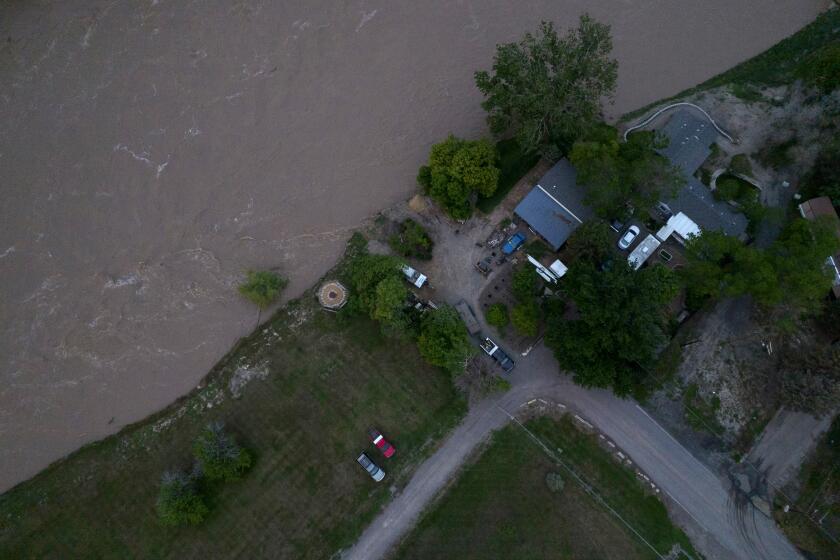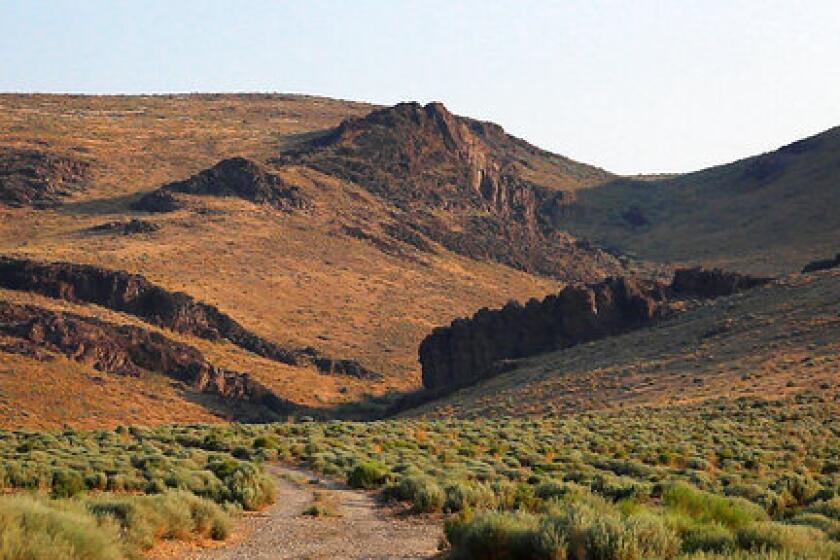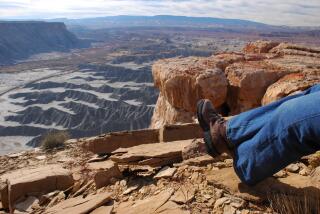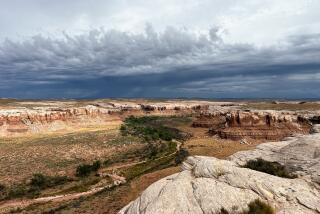Op-Ed: How the U.S. came to protect the natural world — and exploit it at the same time

- Share via
You might come across the remnants of a tramway or a pile of mine tailings or a rusted tank — if you know where to look in Death Valley National Park, Wrangell-St. Elias Park and Preserve in Alaska, Glacier Peak Wilderness in Washington’s Cascade Mountains or Bears Ears National Monument in Utah.
It can be startling to discover the artifacts of industrial activity in an otherwise tranquil natural scene. Miles inside a national park, a designated wilderness or some other conservation area, the remnants of mining claims are everywhere.
With resource development on public lands once again a matter of national debate, it has become increasingly important to ask: How did protected places and mining become so entangled?
One hundred and fifty years ago, Congress established two foundational precedents for our national landscape a mere 10 weeks apart: the Yellowstone National Park Act, setting in motion what would be called America’s best idea; and the General Mining Act, which opened public lands to mining exploration. President Grant appeared to play both sides, making it impossible to settle and privatize public land in Yellowstone while making it easy to extract valuable minerals from almost anywhere without requiring the finders to pay a cent.
Floodwaters that swept through Yellowstone National Park may have permanently altered the course of a fishing river and forever changed the landscape.
These competing priorities ushered in a new regime of land tenure in the U.S., based on a fundamental notion of American land defined by a history of expropriation from Indigenous peoples, economic liberalism and segregated land uses.
When Grant signed the Yellowstone National Park Act on March 1, 1872, it “set apart as a public park or pleasuring-ground for the benefit and enjoyment of the people” some 2 million acres in the northwestern corner of Wyoming, leaning just a bit into Idaho and Montana. In this remarkable landscape of geysers and bison and bright sulfuric pools, no one was permitted to settle or occupy the land. Resources such as timber and minerals were to be kept “from injury or spoliation,” and all natural spectacles would be retained in “their natural condition.” No “wanton destruction” of game or fish “for the purposes of merchandise or profit” would be permitted.
The following May 10, Grant signed into law a bill that has facilitated wanton destruction across many of the country’s public lands and created massive wealth for a few. The General Mining Act of 1872 declared all land in the public domain where valuable minerals might be found to be “free and open to exploration and purchase.” This legislation legitimized mining on all surveyed or unsurveyed lands for personal or corporate gain. The law remains in effect today.
Both laws thrummed with the cadence of dispossession. From the earliest days of the republic, the nation’s policy was to take land from Indigenous peoples — by war, by treaty, by duplicity and fraud — and transfer it into the private hands of yeoman farmers producing food and virtue on homesteads scattered across the continent.
These 1872 laws were possible partly because the federal government had ended treaty-making with Indigenous tribes in 1871. The wide open “pleasuring-grounds” of Yellowstone are “empty” only because of the forced absences of Apsaalooké and Shoshone peoples, and the same is true for other Indigenous nations in subsequent public parks.
Similarly, the great mineral rushes, both before and after the 1872 law, routinely invaded Indigenous territory, often in explicit violation of treaty agreements. This stripped land, wealth and health from Indigenous peoples and provoked ongoing violence, exemplifying a common North American story.
The 1872 laws made land either a museum or a sacrifice zone, not a place to live. National parks — and later, national forests, monuments, grasslands or wildlife refuges — and mining sites that had been home to Indigenous populations quickly redefined those former residents as trespassers.
Both laws also benefited corporate boards. The Northern Pacific Railroad’s tracks were not yet laid down, but the route took it near Yellowstone’s northern boundary. Like many of the transcontinental railroads, the Northern Pacific faced financial trouble and fiercely guarded its territory from its competition. Jay Cooke, the head of the railroad, saw the potential park as a future revenue stream and used his influence to encourage Congress to create it, entwining corporate interests with the national parks.
The General Mining Law also benefited entrepreneurial and corporate development in a much more straightforward way. Obtaining land for mining was simple: Locate valuable minerals, then claim and take them. If they wanted, mineral developers could pay the low fee of $2.50 or $5 per acre (depending on the type of claim) to buy the land.
President Joe Biden is turning to a Cold War-era law to boost production of lithium and other minerals used to power electric vehicles.
These easy terms conformed to a guiding belief of 19th century economic liberalism: The government was supposed to facilitate economic development — and then stand back. The federal government and U.S. taxpayers receive no royalties from the minerals subject to the mining law. Over the next century, an area almost the size of Connecticut dropped into private hands on the cheap.
The General Mining Law brought about major environmental harms that included creating terrible waste — and continues to do so. Although few large-scale hard-rock mining operations have launched in recent decades, 100 million acres of public land can still be explored and, if minerals are located, the process of claiming and taking them is largely the same as it was in the 1870s. Though Congress instituted a moratorium in the 1990s on patenting the claims, ending outright ownership, extracting minerals does not require land ownership — and mining claims close off the lands to other uses.
Meanwhile, environmental regulations and the bonds posted to support reclamation often are insufficient. More than 50 billion tons of waste have been left behind after mining and processing, harming all manner of lakes and lands surrounding mines. The law’s few reforms include a leasing system for some resources (such as coal and gas) and improved environmental remediation. But the General Mining Law enjoys strong allies in resource-dependent congressional districts that have resisted the few calls for fundamental reform, such as royalties and a fund to clean up abandoned mines.
How can we square President Grant’s contradictory imperatives — to protect the natural world at all costs versus exploiting it without concern?
Both laws seized land from its original inhabitants and also revealed a fundamental idea that animates American culture and law: Land is meant to be owned or controlled. From that perspective, tonnage and tourism, price per ounce and entrance fees, show themselves as simply different forms of commodification. While open-pit mines are distinctly different from, say, the Grand Canyon, both require — according to the prevailing ethos — an owner or management goals approved by Congress.
People have inhabited the continent since time immemorial, but this system is only a century and a half old. Outdated laws can be made more equitable.
Adam M. Sowards is an environmental historian and writer. His most recent book is “Making America’s Public Lands: The Contested History of Conservation on Federal Lands.” This article was produced in partnership with Zocalo Public Square.
More to Read
A cure for the common opinion
Get thought-provoking perspectives with our weekly newsletter.
You may occasionally receive promotional content from the Los Angeles Times.












